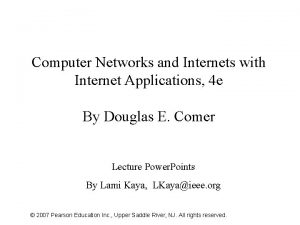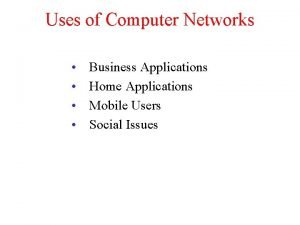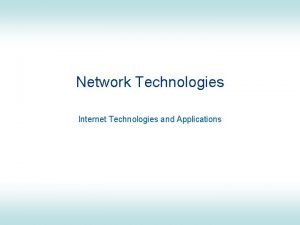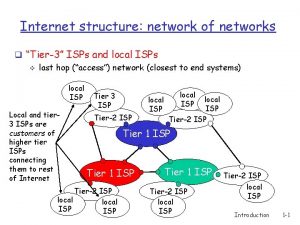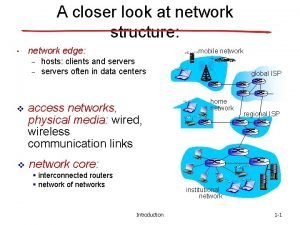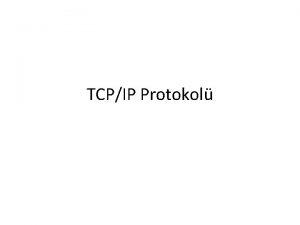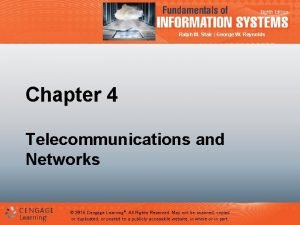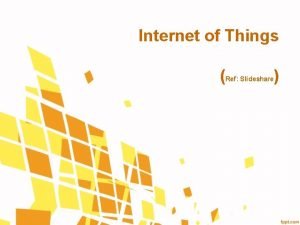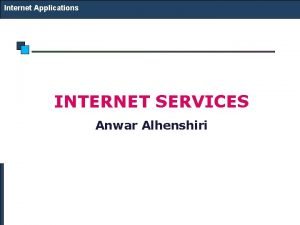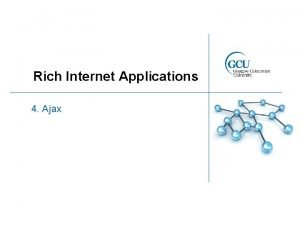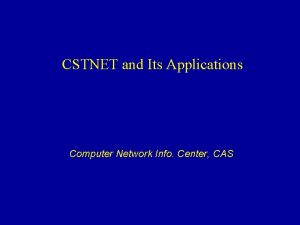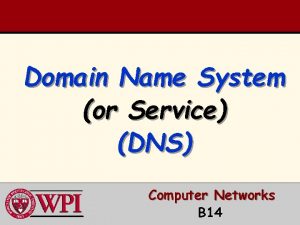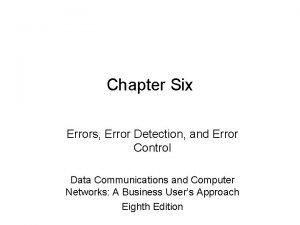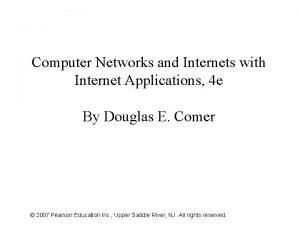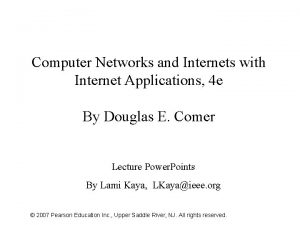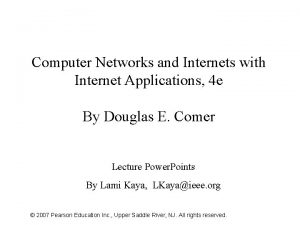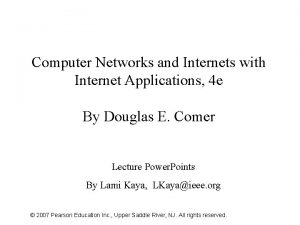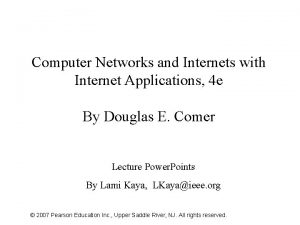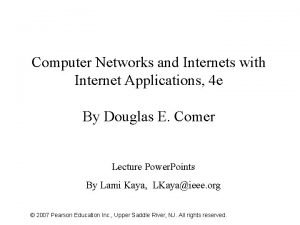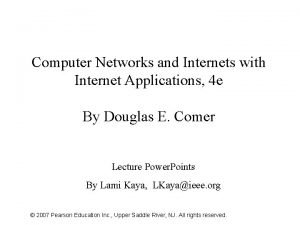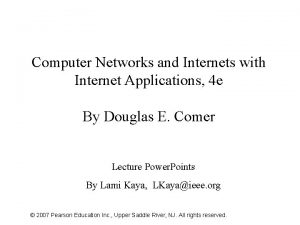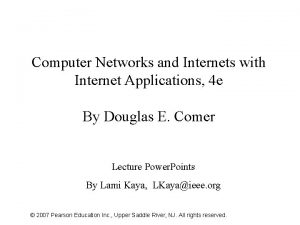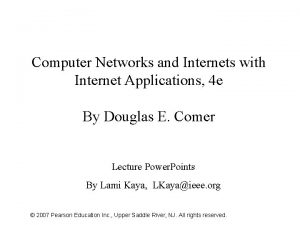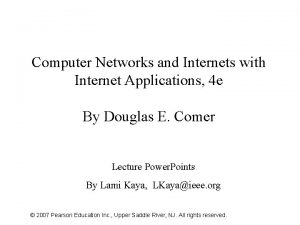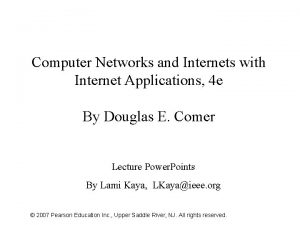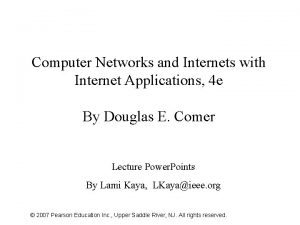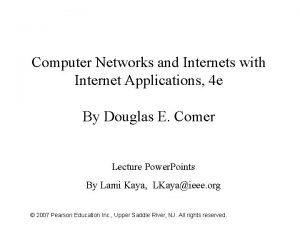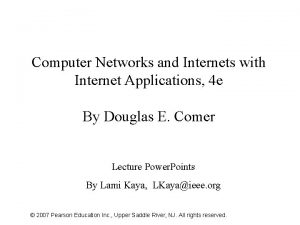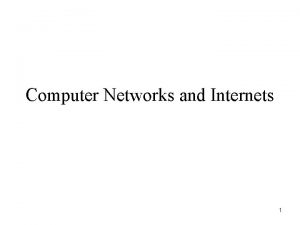Computer Networks and Internets with Internet Applications 4
















































- Slides: 48

Computer Networks and Internets with Internet Applications, 4 e By Douglas E. Comer Lecture Power. Points By Lami Kaya, LKaya@ieee. org © 2007 Pearson Education Inc. , Upper Saddle River, NJ. All rights reserved.

Chapter 13 WAN Technologies And Routing © 2007 Pearson Education Inc. , Upper Saddle River, NJ. All rights reserved.

Topics Covered • • • 13. 1 Introduction 13. 2 Large Networks And Wide Areas 13. 3 Packet Switches 13. 4 Forming A WAN 13. 5 Store And Forward 13. 6 Physical Addressing In A WAN 13. 7 Next-Hop Forwarding 13. 8 Source Independence 13. 9 Relationship Of Hierarchical Addresses To Routing © 2007 Pearson Education Inc. , Upper Saddle River, NJ. All rights reserved.

Topics Covered (cont) • • 13. 10 Routing In A WAN 13. 11 Use Of Default Routes 13. 12 Routing Table Computation 13. 13 Shortest Path Computation In A Graph 13. 14 Distributed Route Computation 13. 15 Distance Vector Routing 13. 16 Link-State Routing (SPF) 13. 17 Example WAN Technologies – – – 13. 17. 1 13. 17. 2 13. 17. 3 13. 17. 4 13. 17. 5 ARPANET X. 25 Frame Relay SMDS ATM © 2007 Pearson Education Inc. , Upper Saddle River, NJ. All rights reserved.

13. 1 Introduction This chapter • considers how those basic technologies can be used to build a NW that spans a large area • describes the basic components used to build a packet switching (PS) system that can span a large area • explains the fundamental concept of routing and shows how routing is used in such NW – a later chapter extends the discussion of routing to the Internet © 2007 Pearson Education Inc. , Upper Saddle River, NJ. All rights reserved.

13. 2 Large Networks And Wide Areas • In general, a NW is classified into one of three broad categories depending on the size – LAN – MAN – WAN • The key issue that separates WAN technologies from LAN technologies is – Scalability – a WAN must be able to grow as needed to connect many sites • A technology is not classified as a WAN – unless it can deliver reasonable performance for large size NW – It must provide sufficient capacity to permit the computers to communicate simultaneously © 2007 Pearson Education Inc. , Upper Saddle River, NJ. All rights reserved.

13. 3 Packet Switches (1) How can a WAN scale to handle many computers? • The network itself must be able to grow • Instead of using a point-to-point (PTP) leased data circuit that connects one computer directly to another, – a WAN is constructed from many switches to which individual computers connect • The initial size of a WAN is determined by the number of sites and the number of computers connected – Additional switches can be added as needed to connect additional sites or additional computers © 2007 Pearson Education Inc. , Upper Saddle River, NJ. All rights reserved.

13. 3 Packet Switches (2) • The basic electronic switch used in a WAN – called a packet switch – It moves complete packets from one connection to another. • Each PS is a small computer, special HW – has a processor, memory, I/O devices used to send and receive • Figure 13. 1 illustrates that a packet switch • Almost every form of PTP communication has been used to build a WAN – Copper cables, optical fibers, microwaves, and satellite channels © 2007 Pearson Education Inc. , Upper Saddle River, NJ. All rights reserved.

© 2007 Pearson Education Inc. , Upper Saddle River, NJ. All rights reserved. 9

13. 4 Forming A WAN • Packet switches are interconnected to form a WAN • A switch usually has multiple I/O connectors – making it possible to form many different topologies and to connect multiple computers • Figure 13. 2 illustrates one possible way to form a WAN • As the figure shows, a WAN need not be symmetric • The interconnections among switches and the capacity of each connection is chosen – to accommodate the expected traffic – to provide redundancy in case of failure © 2007 Pearson Education Inc. , Upper Saddle River, NJ. All rights reserved.

© 2007 Pearson Education Inc. , Upper Saddle River, NJ. All rights reserved. 11

13. 5 Store And Forward • Unlike a shared LAN that allows only one pair of computers to exchange a frame at a given time – a WAN permits many computers to send packets simultaneously • The fundamental paradigm used with wide area PS systems is – “store and forward” switching • To perform store and forward, a PS must buffer packets in memory – the store operation occurs when a packet arrives – the forward operation occurs next • the processor examines the packet • determines over which interface it should be sent • and starts the output hardware device to send the packet • if multiple packets must be sent to the same output device – the PS can hold packets in memory, until the output device is ready © 2007 Pearson Education Inc. , Upper Saddle River, NJ. All rights reserved.

13. 6 Physical Addressing In A WAN • Each WAN technology defines the exact frame format • Each computer connected to a WAN is assigned a PA – the sender must supply the destination's address • Many WANs use a hierarchical addressing – divides an address into multiple parts – the simplest hierarchical scheme partitions an address into two • the first part identifies a PS • and the second part identifies a computer attached to that PS • Figure 13. 3 shows two-part hierarchical addresses • An address is represented as a single binary value – Some bits of the binary value used to represent the first part – Some other bits used to represent the second part – users and application programs can treat the address as a whole • they do not need to know that addresses are assigned hierarchically © 2007 Pearson Education Inc. , Upper Saddle River, NJ. All rights reserved.

13. 7 Next-Hop Forwarding • A PS must choose an outgoing path – If the packet is for one of the computers attached directly, • the switch forwards the packet to the computer – If the packet is destined for a computer attached to another PS • the packet must be forwarded further that leads to the switch • a PS uses the destination address stored • A PS does not keep complete information about how to reach all possible destinations – A switch simply sends to next processing point • Called “next-hop forwarding” – The concept is analogous to the way airlines list flights – Figure 13. 4 illustrates next-hop forwarding in a PS NW – PS usually assigns each interface a small integer, “port #” © 2007 Pearson Education Inc. , Upper Saddle River, NJ. All rights reserved.

© 2007 Pearson Education Inc. , Upper Saddle River, NJ. All rights reserved. 15

13. 8 Source Independence • Next-hop forwarding depends only on the destination – known as “source independence” • Airport analogy: forwarding in an airport is source independent • because the set of outgoing flights does not depend on the city from which a passenger arrived at the airport • Source independence allows the forwarding mechanism – to be compact and efficient – Because all packets follow the same path • only one table is required – Because forwarding does not use source information • only the destination address needs to be extracted from a packet – Furthermore, a single mechanism handles forwarding uniformly • packets that originate on directly connected computers • and packets that arrive from other PS use the same mechanism © 2007 Pearson Education Inc. , Upper Saddle River, NJ. All rights reserved.

13. 9 Relationship Of Hierarchical Addresses To Routing (1) • The table used to store next-hop information is commonly called a – routing table (RT) • The process of forwarding a packet to its next hop is known as – routing • The advantage of two-part hierarchical addressing should be apparent from the RT in Figure 13. 4 – Observe that more than one entry contains the same next-hop value – all destination addresses that have an identical first part will be forwarded to the same PS • Thus, a PS only needs to examine the first part of a hierarchical address © 2007 Pearson Education Inc. , Upper Saddle River, NJ. All rights reserved.

© 2007 Pearson Education Inc. , Upper Saddle River, NJ. All rights reserved. 18

13. 9 Relationship Of Hierarchical Addresses To Routing (2) • Using only one part of a two-part hierarchical address has two practical consequences – First, the computation time required to forward a packet can be reduced • RT can be organized as an array that uses indexing instead of searching – Second, the entire RT can be shortened • to contain one entry per destination PS instead of one entry per destination • The reduction in RT size can be substantial for a large WAN in which many computers attach to a given PS – if K computers attach to each PS, • an abbreviated RT will be a factor of K smaller than a full table • Figure 13. 5 illustrates an abbreviated table for the example NW © 2007 Pearson Education Inc. , Upper Saddle River, NJ. All rights reserved.

© 2007 Pearson Education Inc. , Upper Saddle River, NJ. All rights reserved. 20

13. 9 Relationship Of Hierarchical Addresses To Routing (3) The next-hop forwarding algorithm can be summarized: • To forward a packet when using two-part hierarchical addresses – begin by extracting the part of the packet's destination address that corresponds to a PS, p – If p matches the number assigned to the local PS • use the second part of the address to locate an attached computer – Otherwise • use p to select a next hop from the RT © 2007 Pearson Education Inc. , Upper Saddle River, NJ. All rights reserved.

13. 10 Routing In A WAN (1) • PS having computers attached “interior switches” • PS not having computers attached “exterior switches” • Both interior and exterior PS must have a RT and both types must forward packets • Values in the RT must guarantee the following: – Universal routing • The RT in a switch must contain a next-hop route for each possible destination – Optimal routes • In a switch, the next-hop value in the RT for a given destination must point to the shortest path to the destination © 2007 Pearson Education Inc. , Upper Saddle River, NJ. All rights reserved.

13. 10 Routing In A WAN (2) • The easiest way to think about routing in a WAN is – to imagine a graph that models the network • Each node in the graph corresponds to a PS in the NW – If the NW contains a direct connection between a pair of PS, • graph contains an edge or link between the corresponding nodes • Relationship between graph theory and NW is strong – a machine attached to a NW is often called a NW node • A serial data circuit connecting two machines – is often called a “link” • Figure 13. 6 shows a WAN and the corresponding graph © 2007 Pearson Education Inc. , Upper Saddle River, NJ. All rights reserved.

© 2007 Pearson Education Inc. , Upper Saddle River, NJ. All rights reserved. 24

13. 10 Routing In A WAN (3) • A graph representation of a network is useful – Because a graph represents PS without attached computers • a graph shows the essence of a NW – A graph can be used to compute and understand next-hop routes • Figure 13. 7 shows the RT that correspond to Figure 13. 6 © 2007 Pearson Education Inc. , Upper Saddle River, NJ. All rights reserved.

© 2007 Pearson Education Inc. , Upper Saddle River, NJ. All rights reserved. 26

13. 11 Use Of Default Routes • Although hierarchical addressing reduces the size of the RT – by removing duplicate routes for individual computers • abbreviated RT still contains many entries with the same next hop • Most WAN systems include a mechanism that can be used to eliminate the common case of duplicate entries – Called a “default route” or a “default routing table entry” • the mechanism allows a single entry in a RT to replace a long list of entries that have the same next-hop value – Only one default entry is allowed in any RT, • and the entry has lower priority than other entries – If the forwarding mechanism does not find an explicit entry • it uses the default entry, if exist (optional) • Figure 13. 8 shows how the RT in Figure 13. 7 might be revised © 2007 Pearson Education Inc. , Upper Saddle River, NJ. All rights reserved.

13. 12 Routing Table Computation (1) • How is a routing table constructed? • Manual computation suffices for trivial examples, but – such methods are impractical in large NW s – Consequently, software is used to compute RT entries There are two basic approaches • Static routing – A program computes and installs routes when a PS boots; – the routes do not change • Dynamic routing – A program builds an initial RT when a PS boots; – the program then alters the RT as conditions in the NW change © 2007 Pearson Education Inc. , Upper Saddle River, NJ. All rights reserved.

13. 12 Routing Table Computation (2) Each type of routing has advantages and disadvantages • The chief advantages of static routing – are simplicity and low NW overhead • The chief disadvantage – is inflexibility -- static routes cannot be changed easily • Most NW s use dynamic routing because – it allows the NW to handle problems automatically – For example, programs can monitor traffic in the NW as well as the status of the NW hardware – The programs can then modify routes to accommodate failure • Because large NW s are designed with redundant connections to handle occasional HW failures © 2007 Pearson Education Inc. , Upper Saddle River, NJ. All rights reserved.

13. 13 Shortest Path Computation In A Graph (1) • The SW to compute the entries for a RT represents the NW as a graph, known as Dijkstra's Algorithm (DA) – which finds the distance along a shortest path from a single source node to each of the other nodes in the graph; – a next-hop RT is constructed during the computation of shortest paths • The algorithm must be run once for each RT © 2007 Pearson Education Inc. , Upper Saddle River, NJ. All rights reserved.

13. 13 Shortest Path Computation In A Graph (2) • DA is popular because it can be used with various definitions of “shortest path” – it does not require edges to represent geographic distance – it allows each edge to be assigned a value, called a “weight” – and defines the distance between two nodes to be the sum of the weights along a path between the nodes • DA computes shortest paths in a graph by using weights on edges as a measure of distance – A path with the fewest number of edges may not be the path with least weight • Figure 13. 9 illustrates the concept by showing © 2007 Pearson Education Inc. , Upper Saddle River, NJ. All rights reserved.

© 2007 Pearson Education Inc. , Upper Saddle River, NJ. All rights reserved. 32

13. 13 Shortest Path Computation In A Graph (3) • DA maintains a set of nodes, S – for which the minimum distance and next hop have not been computed • The set is initialized to all nodes except the source • DA then iterates – On each iteration, it selects and deletes a node from S that has the least distance from the source – As it deletes node u , it examines the current distance from the source to each neighbor of u that remains in the set – If a path from the source through u has less weight than the current path • it updates the distance to the neighbor – After all nodes have been deleted from S • it will have computed the minimum distance to each node and a correct next-hop RT for all possible paths © 2007 Pearson Education Inc. , Upper Saddle River, NJ. All rights reserved.

13. 13 Shortest Path Computation In A Graph (4) • DA needs three data structures to store: – The current distance to each node, – the next hop for the shortest path, – and information about the remaining set of nodes • Nodes can be numbered from 1 to n as Figure 13. 9 demonstrates – Doing so makes the implementation efficient because it allows a node number to be used as an index into a data structure • DA uses weight (i, j) as a function that returns the weight of the edge from node i to node j • Function weight is assumed to return a reserved value infinity if no edge exists from node i to node j – In practice, any value can be used to represent infinity provided the value is larger than the sum of weights along any path in the graph – One way to generate a value infinity consists of adding one to the sum of all weights on all edges © 2007 Pearson Education Inc. , Upper Saddle River, NJ. All rights reserved.

© 2007 Pearson Education Inc. , Upper Saddle River, NJ. All rights reserved. 35

13. 13 Shortest Path Computation In A Graph (5) • Allowing arbitrary weights to be assigned to edges of a graph means – one algorithm can be used with different measures of distance – Ex, some WAN technologies measure distance by counting the number of PS along a path • To use the algorithm for such technologies, – each edge in the graph is assigned a weight of 1 • In other WAN technologies – weights are assigned to reflect the capacity of connections • Some WAN technologies assign weights to implement administrative policies © 2007 Pearson Education Inc. , Upper Saddle River, NJ. All rights reserved.

13. 14 Distributed Route Computation (1) • The alternative technique – is a distributed route computation • Each PS computes its RT locally, • Then sends messages across the NW to neighboring PS to inform them of the result • Each PS to send its routing information to neighbors periodically (e. g. , seconds) • After an initial startup period – each PS learns the shortest paths to all destinations – a distributed algorithm (DA) produces the same next-hop RTs as previous algorithm © 2007 Pearson Education Inc. , Upper Saddle River, NJ. All rights reserved.

13. 14 Distributed Route Computation (2) • The continuous periodic messages – allow the NW to adapt if an individual PS or an individual communication link fails • After a failure – a PS stops receiving updates from the HW that failed • The switch continues receiving updates from working neighbors – and if an alternative path exists, the switch can modify its RT to avoid the failed HW © 2007 Pearson Education Inc. , Upper Saddle River, NJ. All rights reserved.

13. 15 Distance Vector Routing (1) • One of the best-known algorithms for distributed route computation – distance-vector algorithm (DVA) • Messages sent from one PS to another contain pairs of values – that each specify a destination and a distance to that destination • Each link in the NW is assigned a weight • The distance to a destination is defined to be the sum of weights along the path to the destination • A PS periodically sends routing information across the NW to neighbors – Each message contains pairs of ( destination, distance ) © 2007 Pearson Education Inc. , Upper Saddle River, NJ. All rights reserved.

13. 15 Distance Vector Routing (2) • When a message arrives at a PS from neighbor N – the PS examines each item in the message – and changes its RT if the neighbor has a shorter path to some destination than the path the PS has been using • Algorithm 13. 2 specifies precisely how routes are updated • DVA for route computation used each PS in a WAN • Each switch periodically sends the list its RT to all neighbors © 2007 Pearson Education Inc. , Upper Saddle River, NJ. All rights reserved.

13. 16 Link-State Routing (SPF) (1) • An alternative form of distributed route computation exists – that uses a version of Algorithm 13. 1 instead of a DVA – called link-state routing (LSR) – the scheme is known as “Shortest Path First” • The name is somewhat misleading because all routing algorithms are aimed to find shortest paths • Each message carries the status of a link between two PS – and the message is broadcast to all switches • Each switch collects incoming status messages – and uses them to build a graph of the NW • Then PS uses Algorithm 13. 1 to produce a RT with itself as the source © 2007 Pearson Education Inc. , Upper Saddle River, NJ. All rights reserved.

13. 16 Link-State Routing (SPF) (2) • Like a DVA, an SPF algorithm can adapt to HW failures • In addition, SPF has the advantage that all computations can be carried out simultaneously – After the status of a link changes, – all PS receive a status message, – and each switch begins computing its RT • In contrast, a DVA it requires a PS to update its RT – before sending a message to another PS © 2007 Pearson Education Inc. , Upper Saddle River, NJ. All rights reserved.

13. 17 Example WAN Technologies • Many technologies have been created for experimental and production use in WAN • This section presents a few example technologies – that illustrate some of the diversity • Next chapter continues the discussion by examining fundamental communication paradigms – and showing which paradigm each technology follows © 2007 Pearson Education Inc. , Upper Saddle River, NJ. All rights reserved.

13. 17. 1 ARPANET • In the late 1960 s, the Advanced Research Projects Agency (ARPA) – Sponsored by USA Department of Defense (Do. D) • A major ARPA research project developed a WAN – to determine whether PS technology could be used in battlefields – Developed network is known as the ARPANET © 2007 Pearson Education Inc. , Upper Saddle River, NJ. All rights reserved.

13. 17. 2 X. 25 • The organization that sets international telephone standards, – International Telecommunications Union (ITU) • developed an WAN technology, and public carriers such as telephone companies have offered the service for many years • The ITU was formerly known as – Consultative Committee for Int. Telephone and Telegraph (CCITT) • The standard is still known as the CCITT X. 25 standard • X. 25 NW s are more popular in Europe than in the US • Each X. 25 NW consists of two or more X. 25 PS interconnected by leased lines that can send and receive packets • Although X. 25 can be used for communication between computers – the technology is expensive for the performance it delivers – and has limits on the speed at which it can deliver data © 2007 Pearson Education Inc. , Upper Saddle River, NJ. All rights reserved.

13. 17. 3 Frame Relay • Frame Relay (FR) is designed to accept and deliver blocks of data – Where each block can contain up to 8 K octets of data • Motivation for the large data size arises – because the inventors designed FR service for use in bridging LAN segments • An organization with offices in two cities can obtain a FR connection for each office • To handle data from a LAN segment – a FR connection must operate at high data rates – FR running at speeds between 4 and 100 Mbps – In practice, many FR subscribers choose to use 1. 5 Mbps or 56 Kbps © 2007 Pearson Education Inc. , Upper Saddle River, NJ. All rights reserved.

13. 17. 4 SMDS • • Switched Multi-megabit Data Service (SMDS) SMDS is designed to carry data SMDS is optimized to operate at the highest speeds Header in packets can require a significant amount of the available BW – To minimize header overhead, SMDS uses a small header and allows each packet to contain up to 9188 octets of data • SMDS also defines a special HW interface used to connect computers to the NW • SMDS NW s often operate at speeds faster than FR © 2007 Pearson Education Inc. , Upper Saddle River, NJ. All rights reserved.

13. 17. 5 ATM • ATM had ambitious goals – it was designed to handle conventional telephone voice traffic as well as data traffic – and to serve as a local area technology as well as a wide area technology • The next chapter describes ATM in more detail © 2007 Pearson Education Inc. , Upper Saddle River, NJ. All rights reserved.
 Computer networks and internets with internet applications
Computer networks and internets with internet applications Computer networks and internets
Computer networks and internets A switched wan is normally implemented as a network
A switched wan is normally implemented as a network Compare internets
Compare internets Backbone networks in computer networks
Backbone networks in computer networks Business application in computer network
Business application in computer network Principles of network applications
Principles of network applications Business application in computer network
Business application in computer network Business applications of computer networks
Business applications of computer networks Internet transport protocol in computer networks
Internet transport protocol in computer networks Aim lans
Aim lans Tier 3 isp
Tier 3 isp Internet structure network of networks
Internet structure network of networks The internet is a combination of networks glued together by
The internet is a combination of networks glued together by Osi vs tcp/ip
Osi vs tcp/ip Integrated and differentiated services in computer networks
Integrated and differentiated services in computer networks Error detection in computer networks
Error detection in computer networks Bit stuffing and byte stuffing
Bit stuffing and byte stuffing Bit stuffing in computer networks with example
Bit stuffing in computer networks with example Rarp cisco
Rarp cisco Analog and digital signals in computer networking
Analog and digital signals in computer networking Web and http in computer networks
Web and http in computer networks Hamming distance in computer network
Hamming distance in computer network Protocols and standards in computer networks
Protocols and standards in computer networks Error detection in computer networks
Error detection in computer networks Applications of internet
Applications of internet Internet of things applications ppt
Internet of things applications ppt Applications of internet
Applications of internet Applications of internet
Applications of internet Rich internet applications with ajax
Rich internet applications with ajax What is computer network and its applications
What is computer network and its applications Internet or internet
Internet or internet Crc in computer networks
Crc in computer networks Crc in computer networks
Crc in computer networks Traffic management in computer networks
Traffic management in computer networks Speed of a computer
Speed of a computer What is optimality principle in computer networks
What is optimality principle in computer networks In band management definition
In band management definition What is optimality principle in computer networks
What is optimality principle in computer networks Classify computer networks based of transmission technology
Classify computer networks based of transmission technology Dns in computer networks
Dns in computer networks Icmp in computer networks
Icmp in computer networks Character stuffing in computer networks
Character stuffing in computer networks Dns in computer networks
Dns in computer networks Data communication assignment
Data communication assignment Difference between computer network and distributed system
Difference between computer network and distributed system Algorithms in computer networks
Algorithms in computer networks Error control in computer networks
Error control in computer networks Subnet
Subnet

